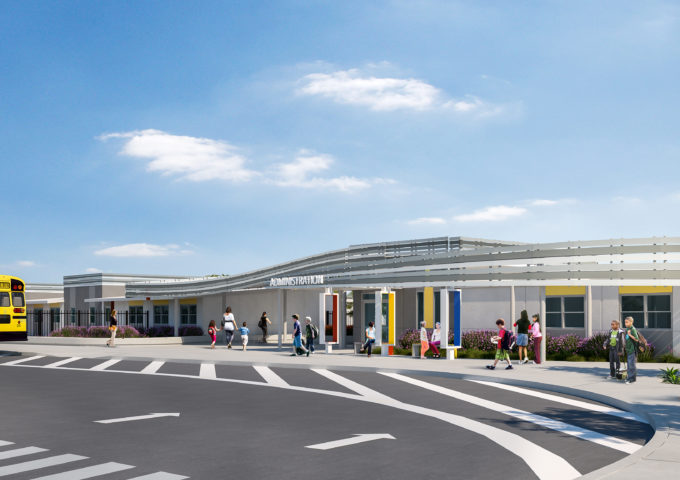Though architects and contractors have explored modular construction’s many iterations and tested its applications in various markets throughout the last 100 years, it’s experienced an evolution in the last decade due to specific challenges to public school districts, specifically in California.
Background
For years, the addition of portable classroom units has been the solution to demographic shifts in public schools with a very challenging budget. In fact, during most of the 1990s the state mandated that all new school construction using state money must consist of at least 30 percent portable classrooms. While the legislature changed in 1998, it left an incentive for school districts to maintain a certain share of portables on their sites. Unfortunately, many of those 20-year-old portables are still in use, with most of them providing a less-than-healthy environment for our students. In 2004, the California Environmental Protection Agency submitted a report to the legislature identifying significant environmental issues found in most portable classroom units. Since then, California school districts have been looking for a solution to this challenge.
Over the past decade, architects and contractors have worked with school districts to substitute portable classroom units for permanent solutions that are cost effective and provide a higher quality learning environment. This effort has prompted a growth opportunity for the modular construction industry. Some existing companies that specialize in portable classroom units now offer “permanent” modular building unit options that offer sustainable features to enhance the quality of the classroom environment and student learning experience.
At HMC Architects, we are exploring opportunities to develop modular building units to provide school districts with a cost-effective alternative to traditional portables.
What is Modular Construction?
The Modular Building Institute defines modular construction as “a process in which a building is constructed off-site, under controlled plant conditions, using the same materials and designing to the same codes and standards as conventionally built facilities—in about half the time. Buildings are produced in “modules” that, when put together on site, reflect the identical design intent and specifications of the most sophisticated site-built facility—without compromise.”
There are two distinctive markets in modular construction: Relocatable buildings and permanent modular construction. While there is still a specific need for the industry of relocatable buildings (portables), most school districts are now interested in permanent modular construction to address facility needs that meet today’s challenging budgets.

Advantages of Modular Construction
Significant reduction in construction schedules. Since modular units are built off-site, the fabrication phase occurs concurrently with other site construction phases such as site preparation, infrastructures, and foundations. Off-site controlled fabrication also significantly reduces delays due to weather. We have found that construction schedules are often reduced by as much as half the time needed for projects using traditional construction methods.
Reduced disruption of school operations. Site construction, at times, can be limited to the assembling of the modular units, minimizing the on-site construction schedule and disturbance of school operations. This also contributes to a safer and cleaner construction site.
A more sustainable process. The modular construction process generates less waste and, because the modular elements are fabricated in a controlled environment using dry materials, the potential for moisture being trapped in new construction is significantly reduced.
Project Delivery Methods
Integrating the benefits of modular construction into the early design phases of the project is critical for taking full advantage of this methodology. Districts and users should be made fully aware early in the process of any limitations in the design of their spaces. Designing within a specific dimensional module, or keeping the building height to specific dimension, will often be a requirement for some manufacturers. For this reason, working in collaboration with a modular building partner during the early project design phases offers a significant advantage to the project.
Today, there are a number of project delivery methods that allow such collaboration. This includes lease-lease back (which is becoming widely used) and design-build. Both methods provide an opportunity for school districts to partner with a contractor and manufacturer early on in the process. In certain instances, it is far more convenient and cost effective for the modular manufacturer to provide the modular building construction documents. Regardless of the delivery method, it is important for school districts to amend traditional requests for qualifications (RFQs), requests for proposals (RFPs), and contracts with service providers to clearly allow these partners to be involved during the project’s design phases.

Design Limitations and Opportunities
Each project has its own challenges and must respond to very unique needs of a specific school site. Every district, campus, and school curriculum is different and the number of potential design solutions for a building can be infinite. Modular construction is limited in that it offers a solution to projects with unique budget and schedule challenges but is not able to (or meant to) address every school program challenge.
Today, there are numerous modular construction manufacturers that have specialized in education projects. Some manufacturers have focused on a specific need, like single classroom buildings, while others have stretched the design umbrella to cover other school functions such as administration buildings, libraries, and even multipurpose and gymnasium buildings. In the process of widening these opportunities, they have created hundreds of pre-checked (PC) units, broken building units into components and system elements, and mastered the coordination process from programming to construction through the use of Building Information Modeling (BIM) and digital manufacturing. While this evolution has opened the market to include all types of buildings on a school campus, the construction cost has increased accordingly. In turn, many general contractors that have historically focused on traditional construction methods for Pre-K–12 projects, have experienced first-hand the benefits of modular construction and are implementing those lessons learned on their non-modular projects. This also allows them to offer more competitive pricing. For example, when designing Esencia K-8 School in Rancho Mission Viejo, CA, HMC saved the school district money by approaching it as a modular design. The project was then bid by a traditional general contractor that took full advantage of the project’s construction modularity, which offered the school district a very competitive price.
The resulting rise in modular construction methodology is creating great opportunities for school districts in California. It’s providing solutions where traditional construction methods may not meet the budget. In turn, school districts continue to stretch tax dollars to maximize student opportunities into more effective and efficient construction technology. Through partnerships with modular construction companies, HMC is able to offer our clients numerous options that deliver 21st century learning environments within budget and on schedule.
Contributing Authors:
Jeff Luchetti, President, JL Construction, Inc.
Kyle Chamberlain, Chief Estimator, JL Modular, Inc.

